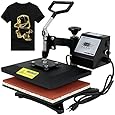Heat Press VS Screen Printing: The Actual Difference
Different Types Of T-shirt Printing Methods: (2018 Updated)
Before you create that T-shirt, you may want to know which printing method to use. Though the heat press and screen printing are the two most common and popular methods these days of printing, we will be describing 3 more methods.
That is important if you want to keep customers coming. Customers can slip away from your sales pipeline if they don't get what they want.
Shop Related Products $69.99
$69.99 $174.99$209.99
$174.99$209.99 $225.99$699.99
$225.99$699.99 $174.78$189.99
$174.78$189.99 $21.74$23.29
$21.74$23.29 $99.50$299.99
$99.50$299.99 $162.59$399.99
$162.59$399.99 $99.49$399.99
$99.49$399.99Customers have become savvy; they know the different printing methods. In your career, you will see that large percentage of your customer have a love for a certain printing method.
Hands down, when you design a t-shirt they sell fast. If you are starting out, you need to test these different methods to know what is appealing to them.
I have seen customers complain about the order they received because it doesn't match their taste and preferences. It can happen to you and that's why you need to be savvy with your customers.
Here are the 5 different printing methods:
1. Screen Printing:
It is the most common with the pros. Another name for this design is silkscreen printing.
For this method to work, you will need a stencil, and a nylon mesh. You set up the stencil, which is held by the nylon mesh. A water proof material will block the negative space that you want to design.
The negative space is the only part permeable for the dye. Ink is then flooded into the screen.
The screen printing method is ideal for printing high-quality t-shirt designs, because it guarantees ultimate replication of the design. The screen printing methods gives a shirt a unique, cute and impressive look that customer love.
Most companies that use the screen printing methods for mass production of t-shirt designs for your business. If you want a single or unique design for yourself, it may be impossible.
This method is suited for one color per screen. It is not ideal for super complex multi-color designs.
2. Direct To Garments(DTG):
Like the screen printing method, it is also popular among hobbyists. It easy to do but it will require knowledge and skills if you are not going to get professional help. All you need for it work is the textile printer and ink .
DTG works like a paper printer in the office. The only difference is that, in this case the ink is going to the fabric. You first need to upload the design to the computer, which then creates uniqueness and creativity.
The Direct To Garment method is excellent for printing out super-complex design. It gives a soft feel on the hands when you touch the final design. The ink used doesn't create thick extra layers on the shirt, because it is thin.
However it has one problem. You can end up with a low resolution design with dot patterns if you have an inferior textile printer. You can't use this method to create design for dark fabric, because the ink is thin and won't look well.
DTG is least durable and the fabric may fade in a year or less.
3. Dye Sublimation:
Dye sublimation works well on light shirts or fabrics. It cost to produce a dye sub but in the end, the customer ends up with a professional done shirt by experts.
To bring out the best results in this method, you need to have deep knowledge in dye sublimation. Dye sublimation is perfect for printing polyester like cream fabrics. They are unforgiving when you bring cotton fabric to the scene.
You will need a special type of dye which is liquid. The liquid dries up when it meets the polyester fabric. When it has dried well, it solidifies on the fabric, then you can apply heat and pressure for sublimation to take place.
When the solid fabric is exposed to heat and pressure it turns into gas. The fabric molecules then expand and the gas sips between the gap that appear in the cloth. In the end, the molecules contracts again when you remove the heat.
Dye sublimation is excellent for printing polyester shirts with minimal enduring designs. Shirt done through sublimation are durable and looks cute.
4. Heat Press Printing:
If you have small orders of shirt, it is economical to use the heat press printing. It saves you resources and time.
This method incorporates a design printed on a special paper called transfer paper. Here is how it works.
You take a shirt, press it on the best heat transfer vinyl, then apply heat and pressure. A more similar approach like the dye sublimation with slight differences. You do the process until the heat softens the dye on the paper until it gets a beneath the cloth.
After that you take the glossy paper transfer and strip off the dye which leaves you with the intended design on the shirt.
If you are working with super complex designs, then heat and press method is ideal for you. However, it won't work well with dark fabrics because of its translucent dye.
Shirts printed through heat press printing are durable.
5. Vinyl Cutting:
In this method a special soft clothing is cut into shapes or designs, then transferred to a shirt.. Then these special designs are then placed onto the t-shirt using the heat press method.
With this method, you can print one-off designs and even produce them in large numbers. It is the best alternative for printing multiple garment types.
Vinyl cutting machine gives you the options of using different layers to print different colors of a design. Vinyl cutting is used in designing sportswear, slogan or small graphics.
However, it suffers from one thing: They are letter-types parts that you can't use with it. T-shirt printed through vinyl cutting are durable.
Conclusion:
Before choosing the best method to print your t-shirt, you need to understand your customers first. Take a survey and know which methods he or she responds best in.
Even the number of orders that you get from that method will tell you what customers want in a design.
I hope this article has opened your eyes into the 5 different printing methods for your t-shirt designs.




